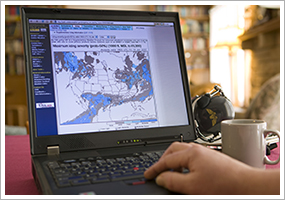| The following stories from the September 17, 2010, edition of AOPA ePilot were provided to AOPA members who expressed an interest in the particular subject areas. Any AOPA member can receive information tailored to their areas of interest by updating their preferences online. |
training tipsDestination weather
In such cases the pilot must construct a weather picture by gathering as many surface weather reports as possible from surrounding points, as recommended in Chapter 12 of the Pilot’s Handbook of Aeronautical Knowledge : “The information gathered for the surface observation may be from a person, an automated station, or an automated station that is updated or enhanced by a weather observer. In any form, the surface observation provides valuable information about individual airports around the country. Although the reports cover only a small radius, the pilot can generate a good picture of the weather over a wide area when many reporting stations are looked at together.” AOPA Airports, the online directory, does that for you when you look up an airport, as this entry for the AWOS-3-equipped Frederick, Md., airport illustrates with the section labeled “METARS from nearby stations.” Some destinations may present greater challenges when you need information about their weather. The Greenville, Maine, airport is situated in locally mountainous terrain and is equipped with limited reporting, according to this note “AWOS–A” in its listing in the digital airport/facility directory. (AWOS-A only provides the altimeter setting.) When en route, consider requesting an informal weather update from the FBO or a pilot on the common traffic advisory frequency. Review Chapter 7 of the Aeronautical Information Manual, which lists the various types of automated weather systems, their capabilities, and their limits. Note that there may be a qualitative difference between automated observations and those made by a human observer. “Human observers take in the entire sky to make judgments about cloud heights, ceilings, and sky cover. They can also identify potentially dangerous cloud types,” wrote Thomas A. Horne in the September 2000 Flight Training article “ The Weather Never Sleeps: ASOS Insights.” However, “To ASOS, a cloud base is a cloud base, whether it's caused by a solitary fair-weather cumulus or a raging cumulonimbus.” Finally, while summer weather may be a memory for many pilots, it lingers in many parts of the country. If you need a brush-up, try the AOPA Air Safety Foundation’s Summer Weather Safety Spotlight. training productsYour solo shirttail, framed for displayHas the shirttail from your first solo been sitting in a box, at risk of becoming a dust rag? Sporty’s will mount your shirttail in a museum-quality custom frame so that you can enjoy it always. Framing costs $125. See the website for details.
Note: Products listed have not been evaluated by ePilot editors unless otherwise noted. AOPA assumes no responsibility for products or services listed or for claims or actions by manufacturers or vendors. final exam
Question: What should a pilot say on initial contact with air traffic control?
Answer: The Aeronautical Information Manual (AIM) is a great resource for radio communications phraseology and techniques. Chapter 4, Section 2 offers several pages on the topic. The recommendation for initial contact is to state the name of the facility being called followed by the aircraft‘s complete N-number or call sign. You may follow that with a short request. If you make a long request on first contact, a controller who is working several aircraft will probably ask you to repeat it. It is best to make your request once ATC has responded to your initial contact. Here are a couple of examples from the AIM: “New York Radio, Mooney Three One Echo” or “Miami Center, Baron Five Six Three Hotel, request VFR traffic advisories.” For more on radio communication, take the AOPA Air Safety Foundation‘s interactive course, Say It Right: Mastering Radio Communication .
Got a question for our technical services staff? E-mail [email protected] or call the Pilot Information Center, 800/872-2672. Don’t forget the online archive of “Final Exam” questions and answers, searchable by keyword or topic. |
 What kind of weather reporting is available at the airport you’ll be flying to on your next cross-country? An ever-growing list of airports is now equipped with weather reporting capabilities. But some destinations still lack weather reporting systems, or only have systems with limited capabilities. That leaves a pilot dependent on indirect methods of knowing what’s up.
What kind of weather reporting is available at the airport you’ll be flying to on your next cross-country? An ever-growing list of airports is now equipped with weather reporting capabilities. But some destinations still lack weather reporting systems, or only have systems with limited capabilities. That leaves a pilot dependent on indirect methods of knowing what’s up.

